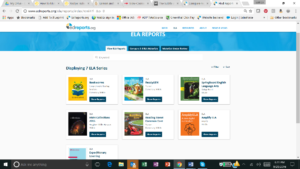

October 17, 2016
We believe at EdReports.org that what is taught matters. Our focus on quality instructional materials comes as more than 90 percent of districts nationwide name finding aligned curricula to be a challenge. In a 2015 National Center for Literacy Education survey, only 51 percent of educators agreed that English language arts (ELA) materials available to them were “well-aligned to the new literacy standards.”
Recently, we published our first 22 reviews of com prehensive literacy programs. Of these, nine met our expectations for alignment and usability; nine partially met expectations for alignment; and four did not meet these expectations. We strongly believe in the power of educators conducting these reviews; those working with and for teachers and students are best positioned to synthesize evidence from materials to identify quality and alignment to standards.
prehensive literacy programs. Of these, nine met our expectations for alignment and usability; nine partially met expectations for alignment; and four did not meet these expectations. We strongly believe in the power of educators conducting these reviews; those working with and for teachers and students are best positioned to synthesize evidence from materials to identify quality and alignment to standards.
Our rubric incorporates feedback from a national listening tour, components from existing state and nonprofit review rubrics, and leading research around literacy instruction. Two of the most pressing requests we’ve received have involved identifying the rigor and complexity of texts and how multiple literacy standards are integrated within comprehensive programs.
Determining Text Complexity
Our reviewers first determine text complexity by considering texts as whole pieces and then by unpacking their component parts. Reviewers identify the quantitative measures of the texts using commonly available metrics (e.g., Lexile or ATOS). The quantitative features offer clues into texts’ difficulty, but assessing complexity also requires assessing qualitative features. Our reviewers examine language features, knowledge demands, meanings of the content, and text structures to make these determinations. Through these lenses, the review team identifies if the text is appropriate for the grade (or grade band).
Overall, reviewers consider the intent and purpose of the text within the larger context of what students learn and practice over a whole school year. This is one practice that makes our reviews unique. Rather than make an appraisal based on only one or two pieces within a program, we take stock of all the components to understand the student and teacher experience and engagement over the course of a full school year. Our initial observations on the first set of reviews include that most programs do include texts with appropriate levels of rigor and complexity for the grade band.
Integration of Literacy Standards
Reviewers identify the speaking and listening tasks as well as the reading, writing, and language lessons included in the materials. Reviewers also identify how these pieces are integrated together in service of supporting students’ literacy development.
We will continue to pay attention to this integration of standards as we conduct more reviews. Across the inaugural set of reviews, reviewers identified an uneven integration of the speaking and listening and language standards, with some programs including them as stand-alone lessons rather than embedding them within a comprehensive literacy experience.
Using the Reviews
K-2 reviews will be published this winter, and we’re already thinking ahead to high school reviews. We hope that educators and adoption teams will use the detailed evidence within our reviews to deepen conversations about instruction and the types of materials that will best support all of the components of literacy to come alive in their classrooms.